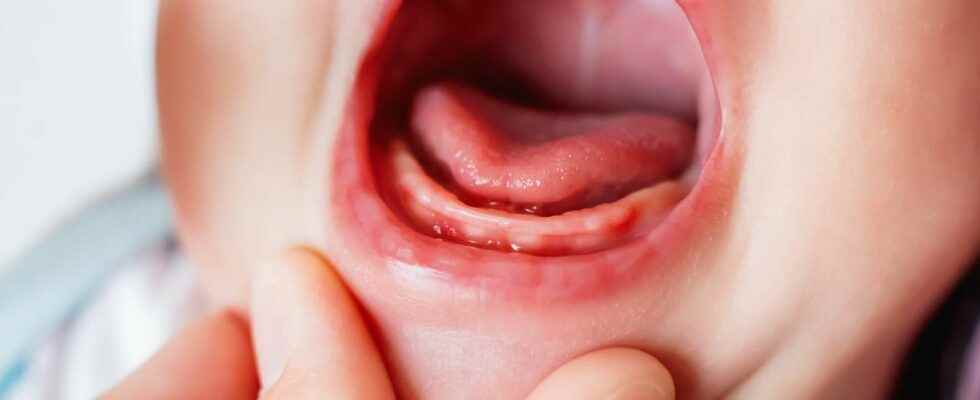In recent years, the notion of a restrictive tongue tie, or ankyloglossia, has resurfaced. Like a fashion, a novelty, tongue brakes are talked about. They are attributed many evils, but it is a divisive subject.
You will also be interested
[EN VIDÉO] The amazing tongue of the bat When Pallas’ glossophagous bat approaches a flower, the blood flow from the taste buds on the surface of its tongue increases. It then lengthens rapidly and allows the animal to drink the nectar with unparalleled speed and precision. Discover in video this astonishing phenomenon.
Ankyloglossia is a anomaly congenital which makes the tongue less mobile. Having an abnormally short lingual frenulum can lead to more or less significant complications depending on the restriction and the body’s adaptation to this constraint.
The repercussions of the tongue tie in babies and young children are:
- Feeding with milk maternal difficulty: possible pains at the breast with deformation of the nipple and cracks; the baby who cannot latch on to the breast is not gaining enough weight. Consequently, there is a risk of possible mastitis, fungal infections breast and a decrease in lactation.
- Food diversification: strong emetic reflex, rejection of pieces, false routes, very long meals even at baby bottle.
- Other: poor dental placement, swallowing and phonation problems, sleeping troubleslifts acidsdifficulties in being calm, mouth breathing, plagiocephaly/dolicocephaly (cranial deformation), ENT disorders…
In adults, in addition to the disorders already mentioned, headaches, backbodily tensions linked to the tensions of the fascia especially. We sometimes note sleep apneafrom bruxism (grinding teeth), cavities, etc These adults sometimes resorted to long orthodontic treatments during their youth.
How to diagnose a lingual restriction?
the diagnostic is installed by a specifically trained professional, after studying the symptomscareful questioning, and following observation and examination of the tongue, face, and oral cavity.
The diagnosis can be made by a chiropractoran osteopath, an ENT, a Speech Therapista midwifea dentist, a lactation consultant, having followed advanced training.
What treatments are offered in the event of a restrictive tongue tie?
Several treatments can be envisaged, by a multidisciplinary team.
- Myofunctional rehabilitation: sessions of osteopathy-chiropractic, speech therapy, exercises to do at home (for a
- better lingual mobility and relieve tension), positioning (stretching of the neck, putting on the stomach)…
- If necessary, in addition to such support, a frenotomy can be proposed: this is a surgery to cut the restrictive brake, in order to release the language. It can be done by scissors or laser depending on the case and the practitioner.
- I’feeding with milk “not shortened” allows better development of the skull and the oral cavity. Breastfeeding consultations with a lactation consultant or a midwife formed are recommended for babies, to promote breastfeeding despite possible difficulties.
A little history
There are traces of stories about tongue brakes for centuries, even more than 2,000 years. We are talking about frenotomies dating from the 16thand century. King Louis XIII himself benefited from this operation in 1610. Some children managed to feed themselves, others were lucky enough to be able to take advantage of several wet nurses (Louis XIV had nearly ten wet nurses whom he injured bleeding while suckling) or alternatives to the breast (animal milk, juice… ).
Sometimes the midwives cut the frenulum with a nail. However, many children may not have survived, unable to feed themselves properly. The tongue brakes being partly genetic, this reduced the number of people affected.
The development of industrial milks and the bottle has allowed a large survival of children by ease of taking from the breast. The number of carrier children has therefore undoubtedly increased, by genetic transmission of a uncomfortable dominant. It is also likely that the current food favors this pathology (endocrine disruptorsconservatives, lack of vitamins…).
Why is this topic controversial?
The knowledge of the tongue brakes has gradually disappeared because of the alternative of baby bottles, and their screening has become increasingly rare. The troubles offeeding with milk were blamed on the mothers: for several decades, the low weight gain of the little ones was blamed on women who were attributed milk that was not very nourishing or in too small a quantity… Babies who struggled to catch the breast and suckling well were called capricious or lazy… Orthodontics allowed the readjustment of the dentition, speech therapy helped to take care of eating and speech disorders.
For some time now, breastfeeding has been back in the spotlight. It is now a public health issue. Professionals are increasingly trained, and parents informed. And recently, restrictive tongue brakes have come back to the fore. We are rediscovering this pathology but it is not a novelty.
In addition, studies on this subject sometimes do not allow us to conclude with certainty: for example, we find 4 to 11% of ankyloglossias according to some studies, in others 35% (Dr Rajeev Agarwaal, 2018), or 28% (Dr. Zarghy). As a result, the care of professionals can be different, with or without operation, multidisciplinary care, language exercises.
Restrictive frenulums are therefore far from being a new pathology, but their recent growth makes them a controversial and little-known subject for professionals and doctors. parents. But we can think that certain problems of breastfeeding, language, eating disorders and many others will be able to benefit from better care in the next few years thanks to more appropriate monitoring of ankyloglossias.
Interested in what you just read?
Subscribe to the newsletter Health question of the week : our answer to a question you ask yourself (more or less secretly). All our newsletters
